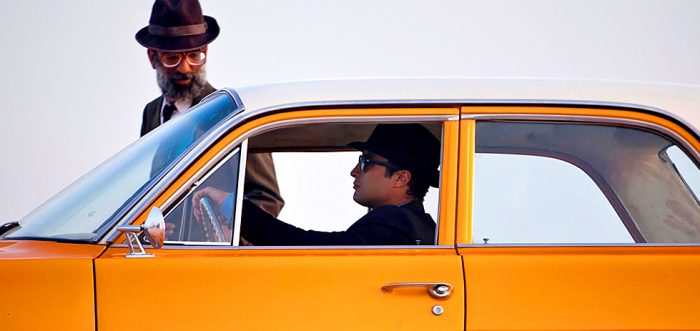
Iranian director Mani Haghighi’s international reputation might stem from earlier directorial efforts such as Men at Work (2006) and Modest Reception (2012), but in large part he’s familiar to many of us through his work as an actor, with roles that include Amir in Asghar Farhadi’s 2009 film About Elly. Haghighi’s understanding of what it takes to make a film work both in front of and behind the camera is wholly apparent in A Dragon Arrives! — he tells his unapologetically complex (even at times consciously convoluted) tale through the nuanced physical gestures of his cast as much as through his screenplay. The skill may (or may not) be in his blood: Haghighi is the grandson of 94-year-old Ebrahim Golestan, an Iranian writer and filmmaker known for fiction, documentaries and — perhaps most of all — for directing and writing the 1965 film The Brick and the Mirror.
Darting between the 1960s and an undefined present, A Dragon Arrives! is a riddle, wrapped in a mystery, inside an enigma that takes the form of a fantasy, wrapped up in a political conspiracy theory, inside a — what the hell, why not — a film noir-imbued mockumentary. A puzzle film where the main challenge is identifying the puzzle in the first place, the story begins (if anywhere) with detective Babak Hafizi (Amir Jadidi), investigating what at first is mistaken for the suicide of an exiled political prisoner who lived inside an abandoned ship in the isolated Qesh region in the Persian Gulf. The burial of the body causes an earthquake, necessitating Hafizi to be joined in his investigation by the hippie sound engineer Keyvan Haddad (Ehsan Goudarzi) and geologist Behnam Shokouhi (Homayoung Ghanizadeh). Much of the story is told in flashback, framed by interviews shot by a documentary filmmaker in the present day. The figures in the film who play themselves in this context are alone impressive, including Haghighi himself, academic Sadegh Zibakalam, journalist and pro-democracy activist Saeed Hajjarian, and Touraj Daryaee, the Maseeh Chair in Persian Studies and Culture and the Director of the Dr. Samuel M. Jordan Center for Persian Studies at the University of California. Added to this mix is the most memorable on-screen ophthalmologist since Joshua Oppenheimer’s The Look of Silence (2014), and a sublime colour palette expertly handled by Hooman Behmanesh (who also shot Haghigi’s earlier Modest Reception).

A Dragon Arrives! is deliberately complex and often opaque. Plot lines are frequently opened up but are rarely followed through; Haghighi seeks to present myriad paths into an unknowable, indefinable future rather than retrospectively using the film’s intricate historical framework to provide any clear-cut conclusions. For some, this — combined with its calculated mishmash of genres, tones and styles — may result in a film that feels overstuffed, but this is precisely where its beauty lies. The magic of A Dragon Arrives! is its refusal to let us to put a finger on what precisely is so compelling about it, what so hypnotically draws our attention into its narrative and aesthetic folds. This is a film that unapologetically refuses to surrender its grasp, long after it has ended.
Consequently, this is a difficult film for which to find a simple point of comparison, but in its genuine free-spiritedness, strikingly original visuals and bold disregard for traditional narrative logic it recalls — on a sensory level at least — Tarsem Singh’s better work, particularly his 2006 magnum opus The Fall. But even this link is tentative, tenuous: for better or for worse, Singh is ultimately an aesthete, while Haghighi has never been afraid to tackle the political dimensions active within his work. As a case in point, Babak’s tale is itself framed story-within-a-story-like by an interview with his superior at Iran’s secret police on 22 January 1965 — the day after the real-life assassination of Iranian Prime Minister Hassan Ali Mansur by a 17-year-old Shiʿite fundamentalist with ties to the “alleged” terrorist organisation Fada’iyan-e Islam. Bokharaei and three others were executed for the assassination, but Mansour took five days to die, during which time acting prime minister Amir-Abbas Hoveida took the reigns, governing the country for the following 13 years. Hoveida was the longest-serving Iranian prime minister, himself executed after the revolution.
For a film with such concrete links to a history that has very real current day repercussions, A Dragon Arrives! is somehow never heavy handed, instead using this backdrop to consciously weave between genres, modes and historical periods with a determined eclecticism. The result is not only a startling tonal and emotional journey, but also a profound and fulfilling one — even for those of us not wholly up to scratch on their 20th-century Iranian political history. This is a rare film that has the ability to remain eerie and abstract without becoming vague or untethered, and further evidence that Iran is one of the leading national cinemas when it comes to understanding the subtle mechanics of experimenting with film genre.
